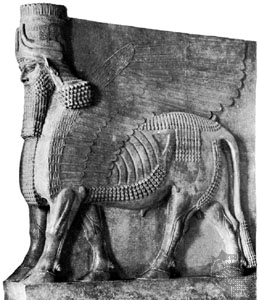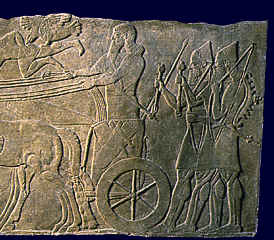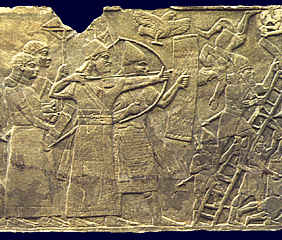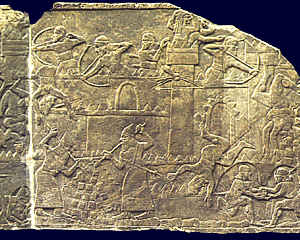Mesopotamian arts and architecture
ASSYRIAN PERIOD: Sculpture
|
Articolo di approfondimento tratto da Enciclopedia Britannica ed.98 Any history of late Assyrian art must be concerned primarily with relief carving. Some statues in the round have been found, but the comparative ineptitude of the majority of them suggests that this form of expression did not come naturally to Assyrian sculptors. Portal sculptures, which many would consider the most characteristic Assyrian art form, are not statues in the round but "double-aspect" reliefs (that is, they are meant to be seen from either the front or the side), apparently derived from a Hittite invention of the 14th century BC. These impressive guardian figures--usually human-headed bulls  or lions--decorate the arched gateways and are sometimes supplemented by others set at right angles on the adjoining facades, their heads facing sideways. Each is composed from a single block of stone weighing up to 30 tons, roughly shaped in the quarry and then carved in situ. Less spectacular orthostat reliefs form a continuous frieze of ornament around the bases of interior wall faces. There is evidence that they were placed in position before the walls that they decorate had been completed. Their carving in situ could thus be executed in full daylight. This form of architectural ornament dates from the first quarter of the 9th century BC and seems to have been a genuine Assyrian innovation. The earliest slabs, from the 9th-century palaces of Ashurnasirpal II and his son Shalmaneser III at Nimrud, are about seven feet (two metres) high, with the design arranged in two superimposed registers separated by a band of cuneiform inscription. In those from later buildings, such as Sargon II's palace at Khorsabad, the individual sculptured figures reach a height of nine feet. The subjects of the designs on these reliefs are rarely related in any way to religion. Superstitious symbols do occasionally appear in the form of benevolent winged beings, or genies, but the primary purpose of the picture is the glorification of the king himself, either by scenes of ceremonial homage or by extended  pictorial narratives of his achievements. The most popular theme,
giving rise to numerous variations, involves detailed scenes
of military conquest and the ruthless suppression of revolt.
These are often arranged episodically to represent successive
events in the progress of a single campaign: the Assyrian army
prepares for war; led by the king, it crosses difficult country
on the way to attack a walled city; the city is taken, burnt,
and demolished; the enemy leaders are punished with conspicuous
brutality; and, finally, the victory is celebrated. Scenes such
as these are distinguished above all by their stylistic vitality
and fanciful detail. Animals as well as men are carefully observed
and beautifully drawn. The principles of perspective as later
defined by the Greeks are unknown, but attention is given to
the relationship of figures in space and to devices for suggesting
comparative distance.
pictorial narratives of his achievements. The most popular theme,
giving rise to numerous variations, involves detailed scenes
of military conquest and the ruthless suppression of revolt.
These are often arranged episodically to represent successive
events in the progress of a single campaign: the Assyrian army
prepares for war; led by the king, it crosses difficult country
on the way to attack a walled city; the city is taken, burnt,
and demolished; the enemy leaders are punished with conspicuous
brutality; and, finally, the victory is celebrated. Scenes such
as these are distinguished above all by their stylistic vitality
and fanciful detail. Animals as well as men are carefully observed
and beautifully drawn. The principles of perspective as later
defined by the Greeks are unknown, but attention is given to
the relationship of figures in space and to devices for suggesting
comparative distance.At Khorsabad, late in the 8th century BC, some notable stylistic changes are perceptible. The lively carving of narrative and historical subjects has been replaced by more tedious symbols of pomp and ceremony. In keeping with the winged bulls and genies of the portal sculptures, stiffly arranged files of courtiers, officials, and servants stand immobilized in the routine of ceremonial homage. The monotony of the figures is occasionally relieved by the sparing use of coloured pigment on the stone. In the 7th-century palaces of Sennacherib and Ashurbanipal at Nineveh, the reliefs suggest a reaction in favour of narrative and violent activity. The slabs are covered to their full height |

 |
|
by complicated battle scenes in which the progress of the fighting is suggested by episodic repetition. Types of landscape are depicted schematically, and significant episodes or individuals are identified by a short inscription, without impairing the overall rhythm of the design. In the intervals between their military campaigns, Assyrian kings appear to have been much preoccupied with hunting, and scenes from the chase provided an alternative subject for the reliefs . Lions hunted with spears from a light chariot and herds of wild asses (onagers) or gazelles are subjects that stimulated the imagination and sensibility of the Assyrian artist. A contrast to these descriptive carvings is provided by the formal monumentality of the Assyrian rock reliefs , secular or religious devices carved on vertical rock faces in localities such as Bavian and Maltai to commemorate historical events that took place there. The Assyrian talent for relief ornament was not confined to sculpture in stone. First seen during the reign of Shalmaneser III (858-824 BC) are striking examples of relief modeling in bronze. The huge wooden gates of a minor palace at Imgur-Enlil Balawat, near Nimrud, were decorated with horizontal bands of metal, 11 inches (28 centimetres) high, each modeled by a repoussé process ( relief hammered out from behind), with a double register of narrative scenes. Their subjects are much the same as the stone reliefs , but even greater ingenuity has been used in adapting the designs to so confined a space. Copyright © 1994-1998 Encyclopædia Britannica, Inc. |
|
|